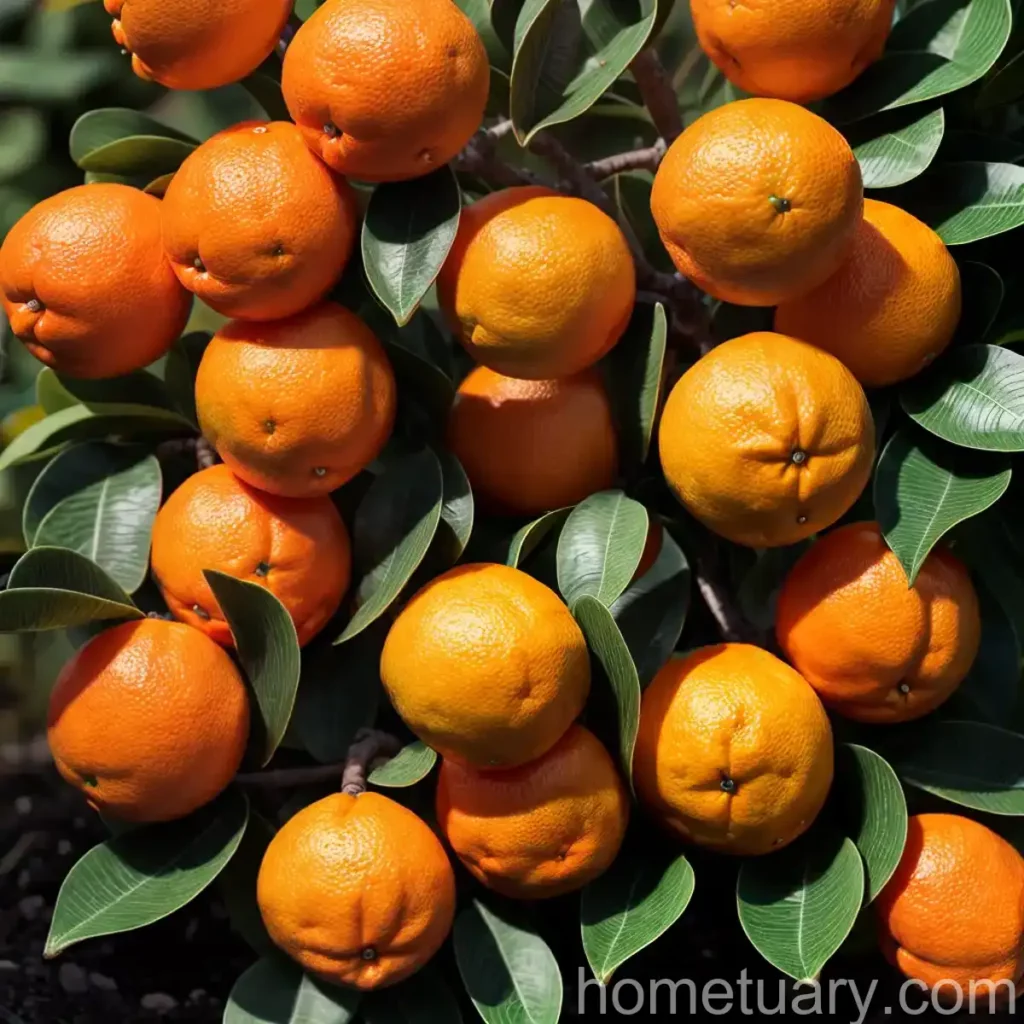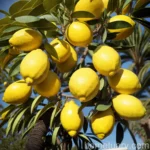The Wonderful World of Mandarin Orange (Citrus reticulata ‘Dancy’)
Mandarin orange, scientifically known as Citrus reticulata ‘Dancy’, is a delightful citrus fruit that not only pleases the palate with its sweet and tangy flavor but also offers a myriad of health benefits. In this comprehensive guide, we will delve into the depths of this vibrant and versatile fruit, exploring its culture, uses, care requirements, and much more. Whether you are an avid gardener, a fruit enthusiast, or simply someone intrigued by the wonders of nature, this article is sure to provide you with a wealth of knowledge about the captivating world of mandarin oranges.
What is Mandarin Orange (Citrus reticulata ‘Dancy’)?
Mandarin orange, a member of the Rutaceae family, is a citrus fruit that belongs to the species Citrus reticulata. The ‘Dancy’ variety is known for its vibrant, thin, and easily peelable skin, along with its juicy and flavor-packed segments. This delightful fruit is appreciated not only for its refreshing taste but also for its incredible versatility in culinary applications and its numerous health benefits.
Key Takeaways – Mandarin Orange (Citrus reticulata ‘Dancy’)
Before we embark on a detailed exploration of the world of mandarin oranges, let’s take a quick look at the key takeaways that we will be covering in this article:
-
Mandarin orange health benefits: A comprehensive overview of the various health benefits associated with mandarin oranges.
-
Citrus reticulata ‘Dancy’ variety: Understanding the specific characteristics and attributes of the ‘Dancy’ variety of Citrus reticulata.
-
Growing tips for Citrus reticulata: Valuable insights into the optimal cultivation practices for Citrus reticulata, with a focus on the ‘Dancy’ variety.
-
Dancy Mandarin orange tree: Exploring the unique features and growth patterns of Dancy Mandarin orange trees.
-
Citrus fruit cultivation: Understanding the broader aspects of cultivating citrus fruits, with a specific emphasis on mandarin oranges.
-
Mandarin orange nutrition facts: A detailed look at the nutritional profile and health-promoting components of mandarin oranges.
-
How to care for Citrus reticulata ‘Dancy’: Practical guidelines for providing the best care and maintenance for ‘Dancy’ mandarin orange plants.
-
Uses of Mandarin orange: Exploring the diverse culinary, medicinal, and practical uses of mandarin oranges.
-
Citrus reticulata species: Understanding the broader taxonomy and species characteristics of Citrus reticulata.
-
Dancy Mandarin orange characteristics: A detailed examination of the unique characteristics that define the ‘Dancy’ variety of mandarin oranges.
With these key takeaways in mind, let’s embark on an enriching journey into the captivating world of mandarin oranges.
Culture
Water
Mandarin orange trees, especially the ‘Dancy’ variety, thrive in well-draining and moderately moist soil. Adequate soil moisture is essential, especially during the flowering and fruit development stages. However, it is crucial to avoid waterlogging, as excessively wet soil can lead to root rot and other detrimental conditions. A regular watering schedule, tailored to the specific environmental conditions and soil characteristics, is essential for promoting healthy growth and robust fruit production.
Sunlight
Mandarin orange trees are renowned for their love of sunlight. They flourish in full sun conditions, where they can bask in the warm rays and soak up the energy needed for vigorous growth and abundant fruiting. When cultivating mandarin oranges, including the ‘Dancy’ variety, ensure that they are provided with ample sunlight, ideally in a location where they can receive at least 6-8 hours of direct sunlight daily.
Fertilizer
Fertilization plays a crucial role in promoting the health and productivity of mandarin orange trees. When it comes to the ‘Dancy’ variety, a balanced fertilizer with a slightly higher concentration of nitrogen can support robust growth and fruit development. It is advisable to fertilize mandarin orange trees in early spring, before the active growth phase, and again in late spring or early summer. Additionally, organic fertilizers rich in micronutrients can be beneficial in ensuring a well-rounded nutrient supply for the trees.
Soil
The ‘Dancy’ variety of mandarin orange thrives in well-draining, slightly acidic to neutral soil. It is tolerant of a range of soil types, including sandy and loamy soils, but it is essential to avoid waterlogged or excessively compacted soil conditions. In regions with heavy clay soils, amending the soil with organic matter and creating raised beds can improve drainage and create an optimal growing environment for mandarin orange trees.
Pruning
Pruning is an essential practice for maintaining the health, shape, and productivity of mandarin orange trees, including the ‘Dancy’ variety. It is generally recommended to prune mandarin orange trees in late winter to early spring, before the onset of new growth. This allows for the removal of dead or diseased branches, shaping the tree for optimal sunlight exposure, and thinning out excessive growth to promote airflow and reduce the risk of pest and disease infestations.
Propagation
The propagation of mandarin oranges, including the ‘Dancy’ variety, can be achieved through several methods, including seed propagation, grafting, and budding. While seed propagation can be a rewarding but time-consuming process, the use of grafting or budding techniques allows for the propagation of true-to-type ‘Dancy’ mandarin orange trees, ensuring the retention of the desired characteristics and fruit quality.
Container Popularity
The ‘Dancy’ mandarin orange tree is well-suited for container cultivation, making it a popular choice for home gardeners and individuals with limited outdoor space. The compact and manageable size of the tree, combined with its ornamental value and fruit-bearing capabilities, makes it an excellent candidate for container gardening. With proper care and maintenance, ‘Dancy’ mandarin orange trees can thrive in containers, providing a bountiful harvest of vibrant, flavorful fruits.
Common Diseases
Mandarin orange trees, including the ‘Dancy’ variety, are susceptible to various diseases that can impact their overall health and productivity. Some of the common diseases that may affect mandarin orange trees include:
- Citrus Canker: A bacterial disease that causes the formation of raised, corky lesions on leaves, stems, and fruit, leading to defoliation and reduced fruit quality.
- Citrus Tristeza Virus: A viral disease that can cause stunted growth, yellowing of leaves, and decline in overall tree health.
- Citrus Black Spot: A fungal disease characterized by the formation of dark, necrotic lesions on leaves and fruit, potentially leading to premature fruit drop and reduced marketability.
Disease Diagnosis
Diagnosing and addressing diseases in mandarin orange trees, including the ‘Dancy’ variety, requires keen observation and proactive management. Regular monitoring of the trees for any signs of disease, such as leaf discoloration, unusual lesions, or abnormal growth patterns, can aid in early detection and intervention. Additionally, consulting with local extension services or plant pathology experts can provide valuable insights into the specific diseases prevalent in the region and the most effective management strategies.
Common Pests
Mandarin orange trees, like many citrus varieties, can fall prey to a range of pests that can compromise their health and fruit production. Some of the common pests that may affect mandarin oranges, including the ‘Dancy’ variety, include:
- Asian Citrus Psyllid: A tiny insect that can transmit the bacterium responsible for Citrus Greening disease, leading to severe damage to the trees and a decline in fruit quality.
- Citrus Leaf Miner: The larvae of this pest can cause unsightly tunneling patterns in the leaves, impacting the tree’s ability to photosynthesize and potentially leading to reduced vigor.
- Scale Insects: These pests can form protective shells on the branches and stems of mandarin orange trees, sapping the plant’s resources and weakening its overall health.
Botanist’s Tips
For those passionate about nurturing and cultivating mandarin orange trees, here are some valuable tips from botanists and horticultural experts:
- When selecting a planting site for mandarin orange trees, including the ‘Dancy’ variety, prioritize locations with well-draining soil and ample sunlight exposure.
- Regular pruning and thinning of branches can promote better airflow and light penetration within the canopy, reducing the risk of disease and enhancing fruit quality.
- Monitoring for signs of nutrient deficiencies and adjusting the fertilization regimen accordingly can support the overall health and productivity of mandarin orange trees.
Fun Facts
- The ‘Dancy’ variety of mandarin oranges is named after A. Dancy, who first cultivated this unique citrus gem in the late 1800s.
- Mandarin oranges are an integral part of Chinese New Year celebrations, symbolizing good luck and prosperity.
- Dried mandarin orange peels are used in traditional Chinese medicine for their aromatic and therapeutic properties.
Links to External Resources
For further exploration of the captivating world of mandarin oranges, the following external resources provide valuable insights and practical guidance:
- University of Florida – Institute of Food and Agricultural Sciences (IFAS)
- University of California Agriculture and Natural Resources
- [Citrus Varieties for the Deep South](http://solutionsforyourlife.com/Citrus_**















